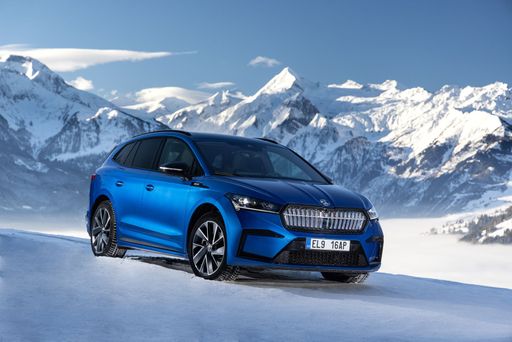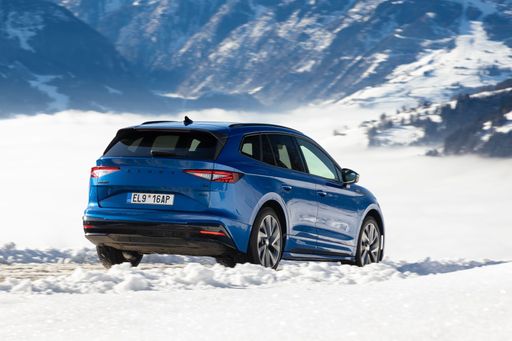Skoda Enyaq vs Volvo EX30 – Which one offers the better deal?
Both models have their strengths – but which one suits you more?
Compare performance, efficiency, price and space directly: Skoda Enyaq or Volvo EX30?
Costs and Efficiency:
Price and efficiency are often the first things buyers look at. Here it becomes clear which model has the long-term edge – whether at the pump, the plug, or in purchase price.
Volvo EX30 has a slightly advantage in terms of price – it starts at 33000 £, while the Skoda Enyaq costs 38100 £. That’s a price difference of around 5066 £.
In terms of energy consumption, the advantage goes to the Skoda Enyaq: with 14.80 kWh per 100 km, it’s a bit more efficient than the Volvo EX30 with 17 kWh. That’s a difference of about 2.20 kWh.
As for range, the Skoda Enyaq performs slightly better – achieving up to 587 km, about 111 km more than the Volvo EX30.
Engine and Performance:
Under the bonnet, it becomes clear which model is tuned for sportiness and which one takes the lead when you hit the accelerator.
When it comes to engine power, the Volvo EX30 has a distinct edge – offering 428 HP compared to 340 HP. That’s roughly 88 HP more horsepower.
In acceleration from 0 to 100 km/h, the Volvo EX30 is clearly quicker – completing the sprint in 3.60 s, while the Skoda Enyaq takes 5.40 s. That’s about 1.80 s faster.
There’s no difference in top speed – both reach 180 km/h.
There’s also a difference in torque: Skoda Enyaq pulls noticeable stronger with 679 Nm compared to 543 Nm. That’s about 136 Nm difference.
Space and Everyday Use:
Beyond pure performance, interior space and usability matter most in daily life. This is where you see which car is more practical and versatile.
Both vehicles offer seating for 5 people.
In curb weight, Volvo EX30 is hardly perceptible lighter – 1840 kg compared to 2002 kg. The difference is around 162 kg.
In terms of boot space, the Skoda Enyaq offers clearly more room – 585 L compared to 318 L. That’s a difference of about 267 L.
In maximum load capacity, the Skoda Enyaq performs significantly better – up to 1710 L, which is about 710 L more than the Volvo EX30.
When it comes to payload, Skoda Enyaq distinct takes the win – 509 kg compared to 390 kg. That’s a difference of about 119 kg.
Who comes out on top?
Overall, the Skoda Enyaq shows itself to be dominates this comparison and secures the title of DriveDuel Champion.
It convinces with the more balanced overall package and proves to be the more versatile choice for everyday use.
 @ Škoda Auto a.s. / Škoda Storyboard
@ Škoda Auto a.s. / Škoda Storyboard
Skoda Enyaq
Skoda Enyaq
The Skoda Enyaq is a cleverly packaged electric SUV that blends roomy, pragmatic family space with clean, Czech design and sensible value. On the road it’s unshowy but composed, offering serene electric performance and easy-to-use tech — the kind of car that makes daily life smoother without trying too hard.
details @ Škoda Auto a.s. / Škoda Storyboard
@ Škoda Auto a.s. / Škoda Storyboard
 @ Škoda Auto a.s. / Škoda Storyboard
@ Škoda Auto a.s. / Škoda Storyboard
 @ Škoda Auto a.s. / Škoda Storyboard
@ Škoda Auto a.s. / Škoda Storyboard
 @ Škoda Auto a.s. / Škoda Storyboard
@ Škoda Auto a.s. / Škoda Storyboard
 @ Škoda Auto a.s. / Škoda Storyboard
@ Škoda Auto a.s. / Škoda Storyboard
Volvo EX30
The Volvo EX30 arrives as a compact electric with crisp Scandinavian design and a cheeky personality, proving you can be serious about safety and still enjoy a grin on your commute. Its cabin is cleverly packaged and delightfully easy to live with, offering smart tech and practical touches that make it feel like a grown-up's city car with a sense of fun.
details @ Volvo Cars
@ Volvo Cars
 @ Volvo Cars
@ Volvo Cars
 @ Volvo Cars
@ Volvo Cars
 @ Volvo Cars
@ Volvo Cars
 @ Volvo Cars
@ Volvo Cars
 @ Škoda Auto a.s. / Škoda Storyboard
@ Škoda Auto a.s. / Škoda Storyboard
|
 @ Volvo Cars
@ Volvo Cars
|
|
|
|
Costs and Consumption |
|
|---|---|
|
Price
38100 - 52200 £
|
Price
33000 - 49100 £
|
|
Consumption L/100km
-
|
Consumption L/100km
-
|
|
Consumption kWh/100km
14.8 - 16.2 kWh
|
Consumption kWh/100km
17 - 18.7 kWh
|
|
Electric Range
428 - 587 km
|
Electric Range
339 - 476 km
|
|
Battery Capacity
59 - 79 kWh
|
Battery Capacity
49 - 65 kWh
|
|
co2
0 g/km
|
co2
0 g/km
|
|
Fuel tank capacity
-
|
Fuel tank capacity
-
|
Dimensions and Body |
|
|---|---|
|
Body Type
SUV
|
Body Type
SUV
|
|
Seats
5
|
Seats
5
|
|
Doors
5
|
Doors
5
|
|
Curb weight
2002 - 2293 kg
|
Curb weight
1840 - 1960 kg
|
|
Trunk capacity
570 - 585 L
|
Trunk capacity
318 L
|
|
Length
4658 - 4660 mm
|
Length
4233 mm
|
|
Width
1879 mm
|
Width
1838 mm
|
|
Height
1605 - 1625 mm
|
Height
1550 - 1567 mm
|
|
Max trunk capacity
1610 - 1710 L
|
Max trunk capacity
1000 L
|
|
Payload
457 - 509 kg
|
Payload
370 - 390 kg
|
Engine and Performance |
|
|---|---|
|
Engine Type
Electric
|
Engine Type
Electric
|
|
Transmission
Automatic
|
Transmission
Automatic
|
|
Transmission Detail
Reduction Gearbox
|
Transmission Detail
Reduction Gearbox
|
|
Drive Type
Rear-Wheel Drive, All-Wheel Drive
|
Drive Type
Rear-Wheel Drive, All-Wheel Drive
|
|
Power HP
204 - 340 HP
|
Power HP
272 - 428 HP
|
|
Acceleration 0-100km/h
5.4 - 8.1 s
|
Acceleration 0-100km/h
3.6 - 5.7 s
|
|
Max Speed
160 - 180 km/h
|
Max Speed
180 km/h
|
|
Torque
310 - 679 Nm
|
Torque
343 - 543 Nm
|
|
Number of Cylinders
-
|
Number of Cylinders
-
|
|
Power kW
150 - 250 kW
|
Power kW
200 - 315 kW
|
|
Engine capacity
-
|
Engine capacity
-
|
General |
|
|---|---|
|
Model Year
2025
|
Model Year
2024 - 2025
|
|
CO2 Efficiency Class
A
|
CO2 Efficiency Class
A
|
|
Brand
Skoda
|
Brand
Volvo
|
Is the Skoda Enyaq offered with different drivetrains?
The Skoda Enyaq is available as Rear-Wheel Drive or All-Wheel Drive.
The prices and data displayed are estimates based on German list prices and may vary by country. This information is not legally binding.
